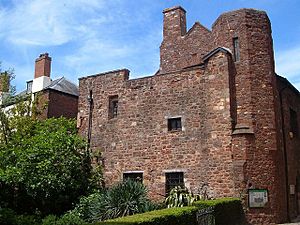Exeter monastery facts for kids
Exeter, a city in England, was once home to many important religious buildings called monasteries and priories during the Middle Ages. These places were like special communities where monks or nuns lived, prayed, and worked together. They played a big part in the city's history!

Here are some of the main monasteries and priories that existed in Exeter:
Contents
Early Religious Buildings (Anglo-Saxon Times)
- Exeter Cathedral Priory: This was possibly started even before the year 690.
- The Saxon Monastery: King Æthelred of Wessex founded this one in 868.
- The Benedictine Monastery: King Æthelstan started this monastery in 932. It was dedicated to Saint Mary and Saint Peter.
- The Nunnery of Saint Augustine: This was a place for nuns (women who dedicate their lives to God). It was founded around 968.
Later Religious Buildings (Norman and Beyond)
- The Benedictine Priory of St Nicholas: This Benedictine monastery was founded in 1087.
- St James Priory: This was a Cluniac priory, started in 1146. Cluniac monks followed a special set of rules.
- Polsloe Priory: This was another Benedictine priory, but it was for women (nuns). It began around 1159.
- Exeter Blackfriars: This was a Dominican friary, founded before 1232. Friars were like monks but often lived among people to preach.
- Exeter Grey Friary: This was a Franciscan friary, started before 1240. Franciscans were another type of friar.
- Exeter Priory: This was planned as a Carthusian priory in 1331–2, but it was never actually built.
Exeter's Monastic History
How Monasteries Started in Exeter
We don't know exactly when monasteries first appeared in Exeter. Christianity arrived in Britain when Exeter was a Roman city. Later, during the 400s, a type of Christianity called Celtic Christianity came to the area. This was brought by missionaries from Wales, Ireland, and Brittany.
Exeter was part of a kingdom called Dumnonia after the Romans left. The Saxons didn't reach the city until 682. That's when King Centwine of Wessex defeated the British people there. The Saxons even called Exeter Monkton because it had so many monks!
Famous Saints and Rebuilding
A priest named Willibald wrote about Saint Boniface. He said the saint was educated at a monastery in 690. This monastery was in a place that people think was Exeter.
Sadly, the Danes attacked Exeter in 1003. They sacked the city, meaning they stole from it and caused damage. But the Benedictine monastery was rebuilt by King Cnut in 1019.
Changes to the Cathedral
In 1046, a man named Bishop Leofric became the bishop for two areas: Cornwall and Crediton. In 1050, he combined these two areas to create one large area called the See of Devon and Cornwall. He then moved the main church (the episcopal see) to Exeter.
This new combined church included Exeter's three main religious buildings at the time. These were the Nunnery of Saint Augustine, the Saxon monastery, and the Benedictine monastery. They were all joined together to form the Cathedral Church. The monastery part was then changed into a secular cathedral. This meant it was run by priests who didn't live under strict monastic rules.
The End of the Monasteries
Over the next two centuries, many more priories and friaries were started in Exeter. But then, a big change happened. King Henry VIII decided to close all the monasteries and religious houses in England. This event is known as the Dissolution of the Monasteries. After this, very little of these old buildings remained.
What Remains Today
Today, only one building from Polsloe Priory still stands. It's the main part of the west side, built from local red sandstone. Experts believe it dates back to around 1320.
From St James Priory, there's only a cob wall left. This wall surrounds a building that's there now. It might have been part of the priory's outer wall.
Parts of the Benedictine Priory of St Nicholas have also survived. The guest wing and a kitchen were turned into a house after the priory closed. This house is now the St Nicholas' Priory museum, run by Exeter City Council. The refectory (dining hall) was also used as a house and is now owned by a trust that protects historic buildings.

